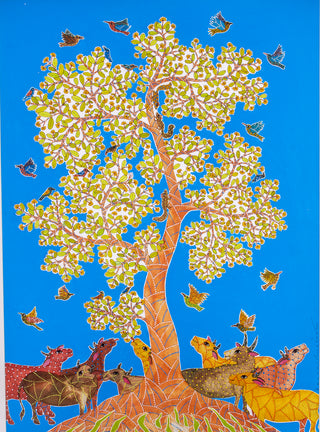This product will be custom-packed and shipped, and charges for the same will be additional. Please contact us on +91 9892213907 for assistance with completing your order.
Artist: Wolf
Medium / Materials: A found wooden table top, an antique Varahi head (acquired as a Varaha mask used in performances of Varaha mythology), fine metal mesh scrap, embroidery using glass beads, buttons from the Kabaadi market, cogs from discarded wall clocks, motorcycle chains
Size: 18 x 11 inches
Year: 2021
The Blue Varahi head, surrounded by a ruff, probably the item of clothing most associated with Elizabethan England.
How did this Era get named after a woman, during an absolute patriarchal time? Was it only because she came to rule? Named after a woman nonetheless…!
Her reign was a time of the flowering of arts, music and literature, of peace and prosperity. Her long reign created stability. “The general opinion at the time was that governing was an art accessible only to men; a female head of state was an offense against nature” (Kirkland and Papp). Queen Elizabeth was entirely against this mindset and because she didn’t want to be under a man’s authority, she instead ruled for 45 years unmarried and independently.
The ‘cloth’ used for the ruff is woven metal. It speaks of the hardships endured to put forth ‘her’ ideas.
16th-century sumptuary laws (sumptuous and consumption sum up the intent - to regulate expenditure and personal behaviour) dictated the clothes, colors, materials associated with each societal rank - and often prohibited “unnecessary” foreign goods
Blue ruffs were banned by the Queen because blue was the colour of Scotland’s flag and she saw Mary Stuart, Queen of Scotland as a threat to her. Here, we are drifting towards the blues to stand up and break the rules which pit woman against woman.
Buttons to symbolise the connectedness of all things and her necklace of cogs from watches, an analogy for her ‘golden period’.
Adding product to your cart


